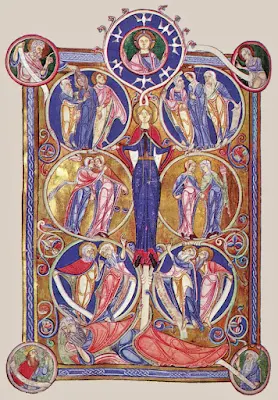Madonna and Child with Half-Eaten Pear, by Albrecht Dürer
This painting, dated 1512, is influenced by the style of the Italian Renaissance, but was painted by the German artist Albrecht Dürer. It shows Mary and Christ, each regarding the other with a touchingly loving gaze, and Christ holding a half-eaten pear. Because of its sweetness, in Western iconography the pear is often associated with the fruit of the Tree of Life. This fruit, which our first parents, Adam and Eve, never ate, contains the promise of eternal life. Church Fathers such as Ephraim the Syrian speculated that Adam and Eve were expelled from the garden to protect them from the temptation of doing so, so that they could not live forever in a fallen state.
As Christians, we are now given the privilege denied to our first parents until Christ retrieved them from Hades after the Crucifixion. We are now all offered the choice to enter an Eden that is raised in glory to a level greater than that of the prelapsarian paradise. And we can choose to eat the fruit that promises eternal life, which is Christ himself, present in the Eucharist.
Hymns from Orthros (morning prayer), in the Byzantine liturgy (Canons for Tone VI on Sunday), express these same sentiments, and connect Mary, the Theotokos, to the economy of redemption directly:
Canon of the Resurrection:
Deceived in Eden into eating of the tree, our progenitor fell into corruption, disobeying Thy commandment, O all-good Lord; yet, obedient to the Father, O Savior, by the Cross Thou didst restore him again to his original beauty.
To the Theotokos:
Through thee, O most holy one, hath grace blossomed forth and the law ceased its effect; for thou, O pure Ever-virgin, gavest birth to the Lord Who granteth us remission.
Tasting of the tree showed me forth as mortal, but the Tree of Life, Who revealed Himself through thee, O all-pure one, raised up the dead and hath made me an heir to the sweetness of paradise.
In depictions of the Tree of Jesse, we see that Christ is connected to Adam through Jesse, and, crucially, in the line of King David. The genealogy from Abraham to Christ is described in three sets of 14 generations in the Gospel of Matthew (1, 1-17) to establish this connection. The number 14 is associated with King David due to the numerical value of his name in Hebrew ‘gematria’, a numerological system in which Hebrew letters are assigned numerical values, and words or phrases with equal totals are considered to have a mystical or interpretive connection. In this 12th-century English illumination of the Tree of Jesse by an anonymous artist, we see the line from Jesse, David’s father, to Christ, represented by a single figure, Mary, who in this context can also be considered the figure from which springs the Tree of Life. Christ is, according to the hymn above, the fruit - the ‘sweet pear’ - present to us in the Eucharist.



